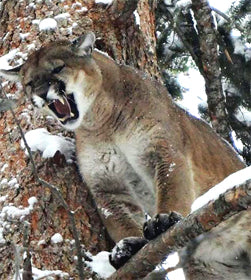
Mountain lions hunting tips and tricks
Mountain lions, also known as cougars, pumas, and panthers, are large, solitary cats native to the Americas. They are the second-largest cat in North America after the jaguar.
They have a long, muscular body with a relatively small head and long tail. Their fur can range in color from light brown to reddish-gray, with kittens having spots that fade as they mature.
Males are typically larger than females and can grow up to 8 feet (2.4 meters) long from nose to tail and weigh up to 200 pounds (90 kilograms) while females achieve around 6 to 7 feet (1.8 to 2.1 meters) long and 100 to 140 pounds (45 to 63 kilograms).
These cats are obligate carnivores, meaning they only eat meat. Their primary prey is deer, but they will also hunt elk, bighorn sheep, raccoons, rabbits, and other animals.
Considering their feeding behavior, mountain lions are extremely adaptable animals and can be found in a variety of habitats, including forests, mountains, deserts, and grasslands.

They use to be solitary except for mothers raising their young. They are excellent climbers and stalkers, and they ambush their prey from behind. Mountain lions are most active at dawn and dusk, but they can also be active at night.
Mountain lions are an important part of the ecosystem, as they help to control prey populations. However, they can be dangerous to humans, and it is important to be aware of their presence if you are spending time in their habitat.
Hunting these animals is not usual because they play a vital role. They keep prey populations in check and ensure healthy ecosystems so regulations and licenses are required with significant variations regarding hunting laws by location. Make sure you have the proper permits before attempting a hunt.
Tracking mountain lions can be dangerous and is generally not recommended for the public. These are solitary predators, and encountering one on their own terms can be risky.
However, if are really interested or need to get involved in this type of hunting, keep in mind the following tips:
First of all, you need to find signs of mountain lions` activity, then scouting is crucial to find signs revealing their presence:
Tracks: Look for paw prints with four toes and one dewclaw. The hind feet will often overlap the front feet. Wildlife agencies can help identify tracks.
Scrapes: Mountain lions leave claw marks on trees to mark territory.
Scat: Mountain lion scat can contain fur and bones of their prey.
Prey: The presence of deer, rabbits, or other prey animals can indicate mountain lions are around.
Once a mountain lion activity area has been found, it's necessary to choose to proper hunting tactic.
Hunting with hounds is the most successful and ethical method. Hounds can track the lion and tree it, allowing a safe harvest or relocation by wildlife officials.
Spot and stalk as well as baiting techniques are generally ineffective for mountain lions.
With the above in mind, it remains clear hounds are your best friends for this adventure however it's necessary to keep in mind that mountain lion hunting with hounds is a controversial practice. Here's a breakdown of both sides:
In Favor:
Safer for hunters: Trained hounds can locate and tree the mountain lion, allowing hunters to see the animal before approaching. This reduces the risk of a close encounter with a potentially dangerous predator.
Selectivity: Proponents argue it allows targeting specific mountain lions. If the animal doesn't meet hunting criteria, the hounds can be called off before a kill.
Population Control: In some areas, wildlife managers might use hound hunting to control mountain lion populations if deemed necessary.
Against:
Stressful for lions: The chase with hounds can be very stressful for the mountain lion. This can negatively impact their health and well-being.
Unfair Advantage: Critics argue using hounds gives hunters an unfair advantage, making the hunt less challenging.
Non-selective Hunting: Some argue that in practice, hunters may shoot the first mountain lion the hounds push towards a tree, regardless of age or sex.
Some additional considerations:
Legality: Hound hunting for mountain lions is legal in some areas but not others. Always check local regulations before embarking on a hunt.
Safety: Even with hounds, mountain lion hunting can be dangerous. Hunters should be aware of proper safety protocols and carry deterrents like bear spray.
Overall, mountain lion hunting with hounds is a complex issue with strong opinions on both sides. If you're considering this type of hunt, it's important to be well-informed about the arguments involved, local regulations, and safety precautions.
At the end of the day, with so many games outside, perhaps leaving mountain lions alone is the best choice, hunting them only when strictly necessary because of human or cattle safety reasons.
Article developed with the help of gemini.google.com



